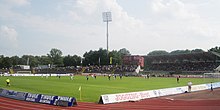Ulm
Ulm is located on the eastern edges of the Swabian Jura mountain range, on the upper course of the River Danube, at the confluence with the small Blau Stream, coming from the Blautopf in the west.The city lies on the international railway corridor "Main Line for Europe", from Paris to Bratislava and Budapest, via Strasbourg, Karlsruhe, Stuttgart, Ulm, Augsburg, Munich, Salzburg, Linz and Vienna.South of the Danube, plains and hills finally end in the northern edge of the Alps, which are approximately 100 kilometres (62 miles) from Ulm and are visible from the city on clear days.The city is divided into 18 districts (German: Stadtteile [de]): Ulm-Mitte, Böfingen, Donaustetten, Donautal, Eggingen, Einsingen, Ermingen, Eselsberg, Gögglingen, Grimmelfingen, Jungingen, Lehr, Mähringen, Oststadt, Söflingen (with Harthausen), Unterweiler, Weststadt, and Wiblingen.Nine districts were integrated during the latest municipality reform in the 1970s: Eggingen, Einsingen, Ermingen, Gögglingen-Donaustetten, Jungingen, Lehr, Mähringen und Unterweiler.These centuries, during which many important buildings were erected, also represented the zenith of art in Ulm, especially for painters and sculptors like Hans Multscher and Jörg Syrlin the Elder.With the establishment of new trade routes following the discovery of the New World (16th century) and the outbreak and consequences of the Thirty Years' War (1618–1648), the city began to decline gradually.In the mid-19th century, the city was designated a fortress of the German Confederation with huge military construction works directed primarily against the threat of a French invasion.The construction of the huge minster, which had been interrupted in the 16th century for economic reasons, was resumed and eventually finished (1844–1891) in a wave of German national enthusiasm for the Middle Ages.Ulm experienced substantial growth in the decades following World War II, with the establishment of large new housing projects and new industrial zones.[14] Examples of these efforts are a biomass power plant operated by the Fernwärme Ulm GmbH (10 MW electrical output), and the world's biggest passive house office building, the so-called Energon, located in the "Science City" near the university campus.[18] The "Bündnis 100% Erneuerbare Energien" was founded in February 2010 with the aim of bringing together the people and organisations seeking to promote the transition to 100% renewable energy in Ulm and Neu-Ulm by 2030.The city's railway station is served, among other lines, by one of the European train routes (Paris – Strasbourg – Stuttgart – Ulm – Munich – Vienna – Budapest).

















Ulm (disambiguation)DanubeUlm MinsterWiblingen AbbeyGermanyBaden-WürttembergAdmin. regionTübingen DistrictUrban districtStadtteileLord mayorTime zonePostal codesDialling codesVehicle registration60th-largest citySwabian JuraRiver DanubeBlau StreamBlautopfBavariaNeu-UlmAlb-Donau-Kreiscity on the Danube RiverRegensburgIngolstadtfree imperial cityUniversity of UlmMain Line for EuropeBratislavaBudapestStrasbourgKarlsruheStuttgartAugsburgMunichSalzburgViennaTrue CrossAlbert EinsteinOtto KässbohrerHildegard Knefabove sea leveltwin citySwabian AlbForeland basinTurritellenplatteBurdigalianNuremberg ChronicleIllerkirchbergHüttisheimErbach (Donau)BlaubeurenBlausteinDornstadtBeimerstettenLangenauElchingenGermanFree Imperial City of UlmFrans HogenbergNeolithicLouis the GermanDuchy of SwabiaImperial CityFriedrich BarbarossaKönigspfalzHans MultscherJörg Syrlin the ElderReformationNew WorldThirty Years' WarWar of the Spanish SuccessionBavarianNapoleonFrench RevolutionGeneral MackBattle of UlmKingdom of Württembergdesignated a fortressGerman ConfederationMiddle Agesconcentration campKristallnachtTheresienstadtThe sole RAF strategic bombing during World War II against Ulmlorry factoriesMagirusKässbohrerWehrmachtDachau concentration campUlm UniversityDaimlerSiemensTurkeyCroatiaBosnia & HerzegovinaRomaniaKosovoSerbiaHungaryPolandhumid continental climateKöppenTrewarthaprecipitationrelative humiditysunshine hoursWorld Meteorological OrganizationSaint GeorgeelectronicspharmaceuticalsbiomedicineBritaxLeipheimGardenaKrieghoffIveco MagirusJ. G. AnschützLiqui MolyMüllerRatiopharmWalther ArmsWieland GroupZwick Roell Group